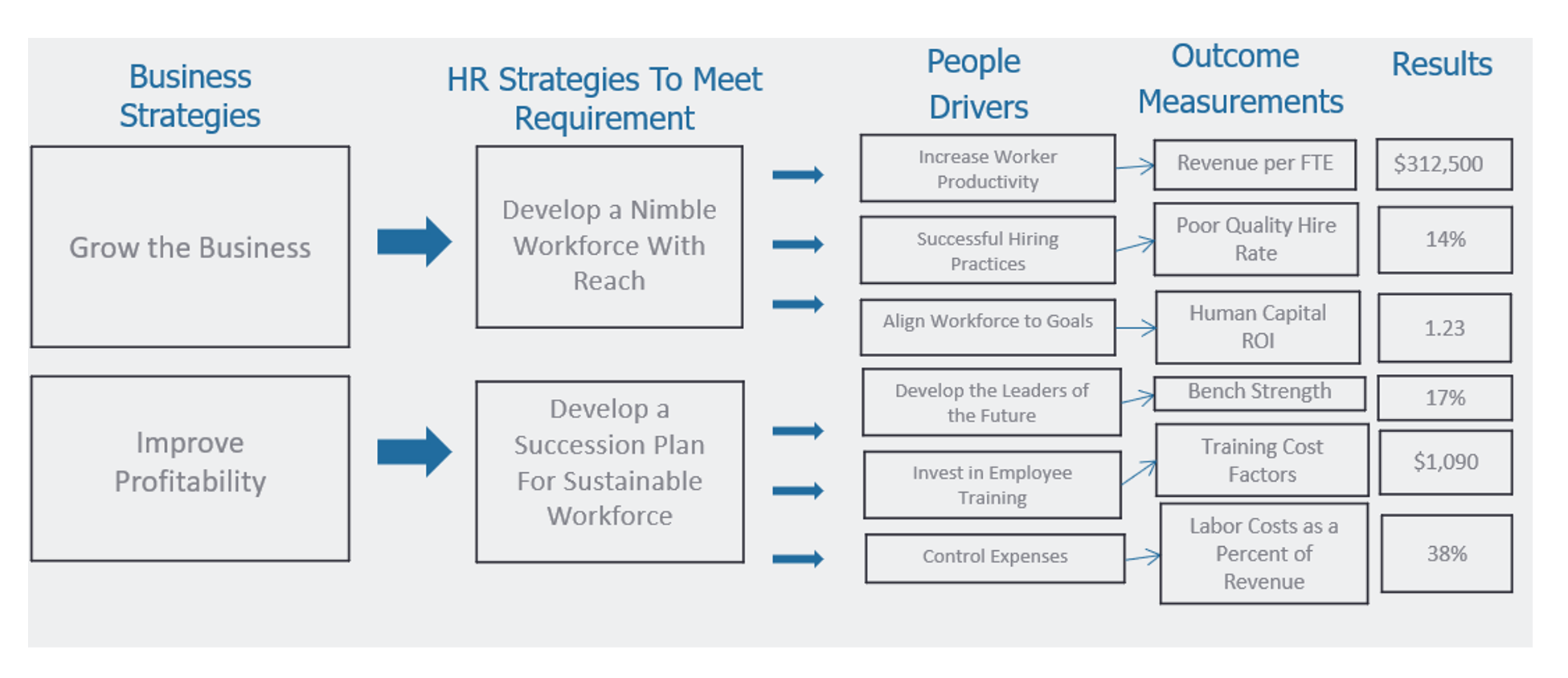To effectively support the business, HR must concentrate on areas that bring value. HR’s strategy must align with and support the business’s strategy. Since it’s not practical to measure everything, how can you make sure what you measure aligns and contributes to the success of your organization?
Let’s start with thinking about business strategy. A business strategy is a long-term plan of action designed to achieve a goal or set of goals or objectives. Strategy is management's game plan for strengthening the performance of the enterprise. It states how the business should be conducted to achieve the desired goals. Without a strategy, management has no roadmap to guide them.
Supporting the business strategy, the HR strategy is the plan for the organization’s workforce. It identifies areas needed to execute business strategies and achieve results. HR’s interventions, including plans, trainings, programs, tasks, and activities, attempt to achieve the strategies and create outcomes through goals or “people drivers”.
Finally, metrics, or outcome measurements, track the effectiveness of the goals or people drivers. Development and use of metrics can demonstrate HR’s value and track its performance. They can show internal progress and improvement and gauge how the organization is doing compared to other businesses. Below is an example of how this process would apply to two business strategies.

Our definition of success drives what we measure. Think about how your organization defines success. For example, what area(s) are you looking for success in: financial success (shareholders), employees (best companies), special interest groups (pollution, animal testing, GMOs), vendors (paying bills), customers (satisfaction, reputation, returning)? The organization’s definition of success is a critical question that goes beyond mission, vision, and values.
The metrics you choose will also depend on how your organization competes (ex. cost, niche, innovation, customer service, etc.). The way you compete, your organization’s culture, and which metrics are useful for you are all connected.
Here are some ideas for metrics based on how organizations compete:
-
Cost
-
Niche
-
Innovation
-
Customer Service
Measuring both leading and lagging HR indicators can help provide an overview of HR’s contributions to the organization’s performance.
Leading indicators measure activities that drive performance and have a significant effect on future performance. Leading indicators measure HR’s actions toward the company’s medium- to long-term success. They show what is currently happening and serve as an early warning sign that change might be needed. Leading indicators will vary based on the organization’s strategy. Examples for HR might be attracting special talent, retention of high performers and those in the succession lineup, quality of hire, customer feedback, succession planning ratio, human capital ROI, or revenue per FTE.
Lagging indicators measure the output of past activities, quantifying results. Most financial measures are lagging indicators. The term "lagging" refers to the delay that occurs between an action and what happened as a result of that action. These measures can be helpful in identifying trends and improving processes and financial performance. Improving them will improve financial performance. The lagging indicators you track should also be selected based on what’s important for your business. For HR, lagging indicators could be turnover rate, time to hire, training costs per employees, or labor costs as a percentage of revenue.
Aligning HR’s strategy and metrics isn’t easy. When done appropriately, it can help focus HR’s efforts on areas that will contribute to the business’s success. Anticipating and creating appropriate actions and activities, then measuring the effect of those actions enhances HR’s value within an organization.
Employers Council is available to help members through online resources, consulting, and training. Contact the Member Experience team by email or call 800-884-1328.
#WorkforcePlanning#StrategicHR